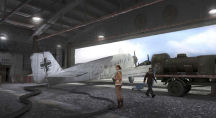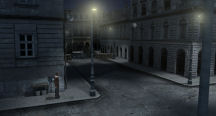What is it?
Undercover: Operation Wintersun is a
point-n-click adventure set in Second World War London and Germany. It is
stated on the official website that the story is completely fictional, but
based upon the controversial theory that Nazi Germany was developing a
nuclear weapon in the early 1940s. What is known is that the Germans did
build an experimental nuclear reactor at Haigerloch, but whether they were
seriously considering building a weapon is unclear.
This game puts you
in the role of Dr. John Russell, a physicist recruited by British
intelligence to go to Germany to investigate the nuclear fission project,
and to discover whether the Germans have a useful nuclear weapon.
The game comes from
Lighthouse Interactive: the same publisher as the Delaware St. John games,
Barrow Hill, and Keepsake. Sproing Interactive, the development company,
is a German software house that has been around for a number of years
(they were involved in the promotion of Zanzarah, an excellent RPG), but
this is the first title of theirs that I've played. The pedigree seems to
be reasonable. So is the game up to the appropriate standard?
Is there a
plot?
There is indeed a
plot, though it's a slow, predictable one with little sense of threat or
peril. Dr. John Russell starts with a simple dialog in London and a small
introductory puzzle, and then is transported into 1943 Berlin -- the heart
of Nazi Germany. During 1943, the Germans were still a major power in
Europe (and beyond), and Berlin was a dangerous place for anyone not
clearly German. And yet, the streets are virtually deserted, and John
Russell and his co-conspirators are able to move around with almost no
fear of detection. This continues when the story moves on to Haigerloch
and, eventually, to Stalingrad (formerly, and latterly known as
Volgograd), where the game does, finally, rise above the snail-like pace
of the earlier locations. This is a linear plot, with very little
opportunity for out-of-order story development. For that matter there is
little character development, or back-story, around the main plot. There
is one twist to the story, but I for one saw it coming from quite early in
the game.
How do you
play?
The user
interface of Undercover: Operation Wintersun is the usual
mouse-based point-n-click. The action is presented in a wide-screen format
across the centre of the screen, with black bars top and bottom. The
inventory pops up into the black bar at the bottom of the screen when the
mouse pointer moves into that area, and the menu becomes available above,
in a similar manner. The inventory items can be left-clicked for a
description or right-clicked for use, either in combination with another
item in the inventory, or with an item in John Russell's surroundings.
Left clicking in the environment is used for movement, but, when clicking
on an object or person, a description is given. Right click is used for
interacting with objects and people, including initiating conversations.
The conversation
tree always appears in the area above the main screen, with a list of
topics John can ask about. Topics that have been used go grey, although
they can be repeated. Topics that have new content (perhaps after an
action on screen, or a conversation with another character) return to
being white text. The dialogue trees are not overly long or deep, but they
are quite dull. When the option presents itself for John Russell to
question the motives of other characters, the resulting dialogue is rarely
very surprising or satisfying in terms of providing depth to the story.
Most of the game
takes place in a third person view, with the characters interacting with
their environment. The environment is displayed in reasonably high detail,
though always from a fixed viewpoint. The camera position cannot be moved
at all. A feature I did enjoy was that there are many things in the
environment upon which John Russell will comment if you click upon them.
This includes many items that you cannot use or move, but that just add
decoration or context to the environment. These could be viewed as red
herrings, but I think many other people will view this as a feature that
improves the quality of immersion within the game world.
The locations are
distinctly well fitted to the intended period of the game. Berlin is a
big, gray city; Haigerloch is a small, provincial German town; Stalingrad,
a bombed out wreck of a city. The actors are animated to an acceptable
standard, though hardly groundbreaking. After all, this isn't a high
budget Dreamworks animated movie. Like the locations, the music fits the
period, or at least the Hollywood interpretation of the period. The music
is unobtrusive, but appropriate to a slow paced spy 'thriller,' though
that's the nearest I'll let that word come to describing this game.
The puzzles
themselves are fair - not too difficult, not too easy, but most are door
puzzles: solve a mechanism to get through the next door. There are just
two timed puzzles, and failure to complete them resets the game to the
beginning of the puzzle. Similarly, there are a couple of occasions where
John Russell (or one of his co-conspirators) can be caught by German
soldiers, or make other fatal mistakes. At these points, the game again
resets to just before the point of the decision.
There are no mazes,
sound-matching, subtle colour-matching, or sliding block puzzles, but
there are chemical, physical, inventory, and logic puzzles. The mechanical
puzzles tend to go to a full screen view with an 'X' in the top right
corner of the screen to pull back to the full screen. Some puzzles reset
on exit, some do not, and there is no indication upon starting a puzzle
what type you're dealing with.
Finally, a warning:
you will need to use a walk-through or the game's 'Novice Mode' (explained
below), unless you can find hotspots that are about two pixels across.
There are a number of puzzles and inventory items that are tiny! Without
assistance, the only way you'll ever find these items is by sheer dumb
luck (my approach), or by moving your mouse pointer over every bump and
dimple in the environment on every screen looking for these elusive (and
important) items.
Notable
Features
There are not
many particularly notable features of this game, but here a couple that
are worthy of comment. Firstly, there is an option to swap the mouse
buttons, so that all the actions I've described above as left-click, are
now right-click. I wish I'd noticed this early in the game because I kept
left-clicking to do things when I needed to right-click. Secondly, there
is an option that applies a sepia (brown-and-white) filter to the entire
game. I suppose this is an attempt to make the world look how we see it in
old photographs, but since the world has actually always been in colour, I
found this to be pointless.
Whilst we're on the
subject of options and controls, there is a 'Novice Mode' available in the
Video Options from the main screen. This gives a visible indicator of all
the exits available from the current location when you hit the Tab key,
and all the hot-spots in a given location when you hit the Backspace key.
I suppose I would not have had such a problem with finding small objects
if I'd noticed this earlier.
Any other
novelties?
No, not really.
This section is only in this review because it's in all my reviews.
Oddities
It is clear from
the dialogue in Undercover: Operation Wintersun
that it originates with a German company and
has been translated into English. And someone ought to buy the translators
a dictionary. Since when is a blow-torch a 'Bunsen Burner'? Or a big,
electrically operated door a 'Sluice'?
Another
consequence, I suspect, of the move from German to English is the very
wooden voice acting. Now I know that us Brits are supposed to be stiff and
formal, but Dr. John Russell really takes the biscuit. There is hardly any
emotion in his voice -- especially for an academic thrown into the spy
business on the whim of MI6 bureaucrats -- and few of the other
characters are any better.
My final gripe is that I had to push the
Gamma Correction (in the Video Options) to a high setting in order to see
what I was doing in two puzzles. I don't know whether this is what the
designers intended, but it was the only way to see what was going on in
the shadows.
Conclusions
I found Undercover: Operation Wintersun
to be a determinedly average game. It has a lacklustre plot, there is no
sense of 'thrill' to the intended 'thriller', and the acting is wooden.
Technically, it is solid, in that there were no glitches (except that you
can't Alt-Tab away, you have to save, exit, and restart the game), and the
install and the uninstall were painless. Graphically, the game is
consistent and detailed, but it never sparkled.
Grade: C
What do you
need to play it?
Minimum
Requirements:
· Microsoft Windows 98 SE, ME, 2000, XP®
· 1 GHz Intel® Pentium® or AMD® Athlon™
processor
· 256 MB RAM
· 4x CD-ROM/DVD-ROM drive
· Approx. 1 GB free hard disk space
· 64 MB DirectX-compatible graphic card
· DirectX 9.0c
· DirectX Sound Compatible sound card
Recommended Requirements, where different from
the minimum:
· 2.5 GHz Intel® Pentium® or AMD® Athlon™
processor
· 512 MB RAM
· Approx. 2 GB free hard disk space
· 128 MB DirectX 9 support or better (nVidia
GeForce™ 6 / ATI® Radeon® 9600 Pro)
(I used a custom built PC running Win XP Pro
SP2, on an AMD Athlon 64 3500+, with 2048 MB RAM, a C-Media USB sound
system, and an ATI Radeon X1950 Pro 512MB video card)
October 2007
design copyright ©
2007
GameBoomers
Group



